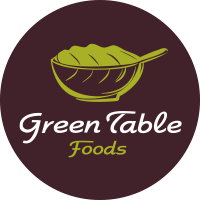These days, Green Table Foods sees barrels of kimchi into more Canadian fine food shops each week. So, what’s the big deal about kimchi?
For starters, South Koreans consume about 1.6 million tons of kimchi per year. No matter the season, the spicy, earthy-tasting dish of fermented vegetables is on the table for breakfast, lunch, and dinner, treated as part of an array of side dishes or used as an ingredient itself: stirred into stews, grilled with meats, wrapped into nori rolls, and steamed with fish or folded into pancakes.
__________
May 7, 2014: Our vegan kimchi was featured in a Toronto Star article and video interview with food reporter Michele Henry! Check it out! Green Table Foods’ vegan kimchi: fermented magic in a jar
__________
The distinctive taste is familiar to anyone who has tried it: the cool crunch of cabbage leaves, the pungent aroma of chile, garlic, and ginger. The longer the kimchi ferments, the stronger its flavour.
Traditionally, kimchi was prepared in autumn for preservation in the winter months, then buried underground in huge earthenware pots. Like all cured foods, kimchi was made to ensure that the year’s harvest did not go to waste and that there was plenty to eat in the cold weather. And in that period of aging when the cabbage naturally ferments, the vegetables’ sugars convert into lactic and acetic acids and carbon dioxide, making kimchi not only delectable but really good for you.
A lot of research has recently come to light, praising the health benefits of kimchi. Health Magazine touts kimchi as the world’s healthiest food, loaded with vitamins A, B, and C. Supposedly, when James Cook set sail in the 1770’s he served his seamen a daily portion of fermented, cured cabbage to prevent scurvy. And although it seems miraculous that Cook had the good sense to do so–when the connection between vitamin C deficiency and scurvy had yet to be proven–kimchi indeed has 42 mg of vitamin C per 10g, which is more than half of the recommended daily allowance.
Kimchi is also probiotic, chock full of “healthy bacteria” called lactobacilli. Like those found in probiotic yogurt, lactobacillus help create a balance in the digestive system, a stable bacterial environment in the digestive tract, and may even help prevent yeast infections, according to a recent study.
In fact, most of the ingredients used to make kimchi such as ginger, pepper, and garlic have all been known to support the immune system and are believed to have the ability to prevent or shorten cold and flu symptoms.
After South Korea began sending soldiers to Vietnam, to fight beside American forces, President Park Chung-hee wrote to President Lyndon Johnson: my troops are desperate for kimchi, he begged. So much so, that the president eventually acquiesced, financing the delivery of canned kimchi to the battlefield.*
So no wonder kimchi finds itself growing ever-globally in popularity. It really only begs the question: What took so long?
__________
* Choe, Sang-Hun. “Starship Kimchi: A Bold Taste Goes Where It Has Never Gone Before” The New York Times. (2008-02-24) Retrieved January 15, 2014.

